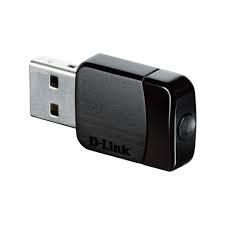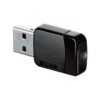D-Link Dwa-171 Ac11 Wireless Dual band USB Adapter
D-Link DWA-171 AC11 Wireless Dual Band USB Adapter transforms any USB-enabled device into a modern dual-band wireless system, providing access to both 2.4GHz and 5GHz frequency bands for improved performance and reduced network congestion. This compact adapter automatically selects the optimal frequency band based on network conditions and distance, delivering faster speeds and more reliable connections than older single-band USB adapters.
Unlike basic wireless adapters limited to crowded 2.4GHz spectrum, this dual-band design allows devices to access the cleaner 5GHz band for high-bandwidth activities like streaming and gaming, while maintaining 2.4GHz compatibility for extended range and older device connections. The adapter provides an economical upgrade path for desktop computers, laptops with failed wireless cards, and specialized equipment requiring modern wireless capabilities.
Dual-Band Wireless Technology and Performance
Frequency Band Management and Speed Distribution
The D-Link DWA-171 AC11 Wireless Dual Band USB Adapter optimizes wireless performance through intelligent band selection:
- 5GHz AC band: Higher-speed connectivity with reduced interference from neighboring networks and household devices
- 2.4GHz N band: Extended range coverage with broad compatibility across older and newer wireless standards
- Automatic band steering: Device connects to the most suitable frequency based on signal strength and network congestion
- Simultaneous dual-band awareness: Can detect and connect to either band depending on router capabilities
Real-World Performance Expectations
Practical throughput testing reveals typical performance across different environments and distances:
- 5GHz close range: Enhanced speeds within 30-50 feet of modern dual-band routers
- 5GHz interference avoidance: Cleaner signal quality in environments with many competing 2.4GHz devices
- 2.4GHz extended range: Reliable connectivity throughout typical home environments and distant rooms
- Mixed network performance: Stable operation in households with multiple wireless devices and varying standards
Compact Design and USB Integration
Physical Form Factor and Portability
Streamlined design balances performance with convenience:
- Compact profile: Small enough for permanent installation without blocking adjacent USB ports
- Portable operation: Easily transported between different computers and locations
- USB 2.0 compatibility: Works with standard USB ports while supporting modern wireless speeds
- Heat management: Efficient thermal design prevents overheating during extended operation
Installation Flexibility and Connection Options
- Direct USB connection: Plug directly into computer USB ports for simple installations
- Extension compatibility: Works with USB extension cables for optimal positioning when needed
- LED status indicator: Visual confirmation of power and wireless connection activity
- Low-profile design: Minimizes risk of accidental damage or disconnection
Operating System Support and Driver Installation
Comprehensive Platform Compatibility
The D-Link DWA-171 AC11 Wireless Dual Band USB Adapter functions across multiple operating systems:
- Windows support: Compatible with Windows 11, 10, 8.1, 8, and 7 with both 32-bit and 64-bit versions
- macOS integration: Supports recent macOS versions through built-in or downloadable drivers
- Linux compatibility: Broad distribution support including Ubuntu, Fedora, and other popular versions
- Driver availability: Manufacturer-provided drivers ensure optimal performance and feature access
Setup Process and Configuration Management
Installation accommodates users with varying technical experience levels:
- Plug-and-play capability: Many modern systems automatically recognize and configure the adapter
- Manual driver installation: Available for systems requiring specific driver versions or older operating systems
- Wireless network management: Standard operating system wireless utilities handle network connections
- Security protocol support: Full compatibility with WPA3, WPA2, and legacy wireless security standards
Practical Applications and Usage Scenarios
Desktop Computer Wireless Enablement
Many desktop systems lack built-in wireless capability, making external adapters essential:
- Gaming desktops: Dual-band wireless for online gaming with reduced latency and interference
- Office workstations: Flexible network connectivity without requiring ethernet cable runs
- Home office setups: Enables wireless connectivity for custom-built computers and older systems
- Media centers: Connects entertainment systems to home networks for streaming and content access
Laptop Enhancement and Replacement Solutions
Existing laptops may benefit from wireless capability improvements:
- Internal Wi-Fi failures: Cost-effective replacement when laptop wireless cards malfunction
- Performance upgrades: Enhanced wireless capability for laptops with older single-band adapters
- Dual-network scenarios: Simultaneous access to different wireless networks for specific applications
- Travel convenience: Portable wireless enhancement for business trips and temporary locations
Network Compatibility and Security Features
Modern Wireless Standards Integration
Advanced protocol support ensures compatibility with current and future network equipment:
- 802.11ac support: Modern wireless standard compatibility with current router technology
- Backward compatibility: Seamless operation with older 802.11n and 802.11g networks
- MIMO technology: Multiple antenna support improves signal quality and reliability
- Beamforming compatibility: Enhanced signal focusing when supported by network equipment
Security Protocol Implementation
Comprehensive encryption support protects wireless communications:
- WPA3 encryption: Latest wireless security standard with enhanced protection capabilities
- WPA2 enterprise support: Business-grade security for corporate and educational environments
- Guest network compatibility: Secure connection to visitor networks with appropriate access restrictions
- Legacy support: WEP compatibility for older networks requiring legacy security protocols
Performance Optimization and Configuration
Wireless Network Optimization
Several factors influence adapter effectiveness in various network environments:
- Dual-band router compatibility: Modern routers provide optimal performance with full feature utilization
- USB port selection: USB 3.0 ports may offer improved performance and reduced interference
- Physical positioning: Adapter orientation and placement affect signal reception quality
- Channel selection: 5GHz band typically offers cleaner spectrum with less congestion
Advanced Configuration Options
Power users can optimize performance through detailed wireless settings:
- Manual band selection: Force connections to specific frequency bands when network conditions require
- Power management: Balance between performance and energy consumption on battery-powered devices
- Connection profiles: Save and manage multiple wireless network configurations
- Roaming optimization: Adjust handoff behavior for environments with multiple access points
Limitations and Alternative Considerations
Technology Constraints and Performance Boundaries
The D-Link DWA-171 AC11 Wireless Dual Band USB Adapter operates within specific technical limitations:
- USB interface bottlenecks: USB 2.0 connection may limit maximum throughput compared to internal wireless cards
- Antenna limitations: Compact design provides adequate but not exceptional signal reception compared to larger adapters
- Power constraints: USB power delivery may limit transmission power and range compared to internal solutions
- Heat sensitivity: Extended high-performance operation may cause thermal throttling in poorly ventilated areas
When to Consider Alternative Solutions
Different wireless solutions may provide superior performance for specific requirements:
- High-performance needs: Internal PCIe wireless cards offer maximum speed and signal strength
- Extended range requirements: USB adapters with external antennas provide superior coverage
- Wi-Fi 6 compatibility: Newer 802.11ax adapters support advanced efficiency features
- Enterprise applications: Business-grade adapters with advanced management and security features
Installation Environment and Optimal Usage
Physical Environment Considerations
Adapter performance varies significantly based on installation location and network conditions:
- Signal strength optimization: Positioning adapter for clear line-of-sight to wireless router
- Interference mitigation: Distance from other electronic devices reduces performance impact
- Temperature management: Adequate ventilation prevents overheating during continuous operation
- USB port accessibility: Convenient access for occasional disconnection and reconnection
Network Infrastructure Requirements
- Dual-band router availability: Full benefits require compatible dual-band wireless infrastructure
- Internet speed matching: Adapter capabilities should align with available broadband speeds
- Network congestion assessment: 5GHz band particularly beneficial in areas with many competing networks
- Security requirement compliance: Adapter must support network security standards used by target networks
Value Assessment and Cost Effectiveness
Budget-Friendly Wireless Upgrading
This adapter provides substantial wireless improvements at reasonable cost:
- Dual-band access: Affordable path to modern wireless technology without premium pricing
- Desktop wireless addition: Less expensive than internal wireless card installation or replacement
- Laptop repair alternative: Cost-effective solution compared to professional laptop wireless repair
- Multiple device utility: Single adapter can serve various computers and scenarios
Long-Term Investment Perspective
Understanding the adapter’s role within evolving wireless technology standards:
- Technology relevance: Dual-band capability maintains value despite emergence of Wi-Fi 6
- Compatibility longevity: 802.11ac support ensures continued functionality with modern networks
- Replacement timeline: 2-4 year useful life before newer standards provide significant advantages
- Secondary application: Permanent value as backup or emergency wireless connectivity solution
Troubleshooting and Maintenance
Common Issues and Resolution Strategies
Typical challenges and their solutions help maintain reliable wireless connectivity:
- Driver installation problems: Clean driver installation procedures resolve compatibility conflicts
- Connection stability issues: USB port changes and power management adjustments improve reliability
- Performance limitations: Network optimization and interference reduction enhance throughput
- Heat-related problems: Improved ventilation and positioning prevent thermal performance degradation
Support Resources and Documentation
D-Link provides essential support infrastructure for wireless adapter users:
- Driver repository: Current and legacy driver downloads for various operating systems
- Installation guides: Step-by-step setup documentation for different platforms
- Troubleshooting documentation: Common problem resolution and optimization techniques
- Technical support: Professional assistance for complex installation and compatibility issues
Maintenance and Care Requirements
Ongoing Device Management
Simple maintenance practices ensure continued reliable wireless operation:
- Driver monitoring: Regular checks for updated drivers improve compatibility and security
- Physical inspection: Periodic cleaning and connection verification prevent gradual performance degradation
- Performance assessment: Occasional speed tests identify potential issues or optimization opportunities
- Configuration backup: Saving wireless profiles prevents reconfiguration after driver updates
Replacement Planning and Upgrade Indicators
Understanding when adapter replacement becomes necessary or beneficial:
- Performance inadequacy: When network speeds consistently exceed adapter capabilities
- Compatibility issues: Driver support discontinuation for newer operating systems
- Hardware failure: Physical damage or component failure requiring replacement
- Technology advancement: Significant wireless standard improvements justify upgrade investment




Reviews
There are no reviews yet.